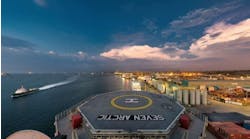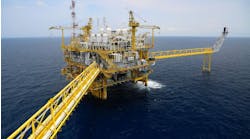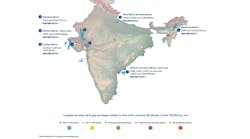Operators target metocean, geotechnical, subsea,
blowout risk, water column issues
blowout risk, water column issues
Nick Terdre
Contributing Editor
In July Diamond Offshore semi Ocean Alliance spudded its fifth deepwater well in series in the Norwegian Sea.Current deepwater drilling on the Norwegian continental shelf is benefiting from the results of an ongoing research program into the problems encountered in such operations. The Norwegian Deepwater Program (NDP) was set up in early 1996, soon after award of the 15th round licences in the Moere and Voering Basins in the Norwegian Sea, and is due to run for four years.
Participating in it are all the seven licences involved: PL 207 (Moere West, operator Esso), PL 208 (BP), PL 209 (Ormen Lange, Norsk Hydro), PL 210 (Helland Hansen, Shell), PL 215 (Gjallar Ridge, Saga), PL 217 (Vema Dome, Statoil) and PL 218 (Nyk High, BP).
The 15th round licences are the first in Norway which involve seriously deep waters - depths to 1,500 meters. In addition, climatic conditions in the Moere and Voering Basins are tough, with frequent storms and strong currents to be contended with. Exploring in such conditions involves higher costs and greater safety and environmental risks, while demanding a higher technical performance than operations in more conventional water depths.
Hence, it made sense to join forces to identify and investigate such problems at a generic level, according to Tony Evans, Norske Shell's exploration team leader for deepwater. By throwing light on the problems, and investigating solutions for them, the program aims to reduce the costs of the actual drilling operations of the individual licences. The work scope also includes expanding the limited state of knowledge of the meteorological and oceanic conditions in the relevant areas.
Cooperative program
"The NDP has been instrumental in reducing a number of concerns which we initially held, and will result in a less conservative design of deepwater installations, which should result in considerable cost savings," Evans says.As an example, direct cost savings have resulted from the joint acquisition of surveys such as the baseline environmental survey and the shallow seismic survey. In addition to a saving of NKr 1.2 million in mob/demob fees for each survey, the joint approach has ensured greater uniformity and better integration of data. Equally important, a greater geographical spread was achieved by collecting data in the areas between licenses.
NDP is a further manifestation of the cooperative approach which the offshore industry in Norway now brings to bear on common problems. It has prompted a positive response among oil companies and authorities, both in Norway and overseas, Evans says.
The program is run by a joint steering committee on which all the licences are represented. Work proposals have to be approved by the various licencees as these are ultimately responsible for funding the program. The total budget to end-1998 is almost NKr 125 million, of which some NKr 50 million will be spent this year. A similar amount is likely to be allocated in 1999.
Work is divided into five main projects - metocean, seabed, subsea, risers/moorings, and environment - which are themselves divided into a further 36 sub-projects.
• Metocean: The metocean project is managed by Shell and has a budget to end-1998 of some NKr 16 million. The program's main objective is to establish a database of metocean conditions for use in operations and the design of deepwater installations based on ocean current and wave data acquisition and analysis, ocean current modeling, and remote sensing for wave analysis.
The intention is to develop an ability in hindcasting which can be extended to forecasting, says Evans. Links have been established with metocean offices in Norway and the UK and universities active in metocean research. Data gathered has highlighted the variabiltity in slope currents.
• Geotechnical research: Norsk Hydro is in charge of the seabed project, which, with a budget of approximately NKr 57 million to end 1998, is the most cost intensive. Shallow gas is widely distributed through the Moere and Voering areas, and the steep nature of the seabed in places causes slide activity.
Main objectives of this project are to understand geotechnical conditions and hazards, develop a regional understanding of shallow sediments, and establish procedures for the identification of shallow hazards and natural gas hydrates.
One important outcome was that a geotechnical borehole campaign targeting bottom simulating reflectors on a number of shallow seismic lines confirmed that gas hydrates were not present, as had initially been supposed. This is a finding which will result in a reduction of costs associated with wellhead design, Evans says.
As regards slope stability, the geotechnical borings also indicated that soil properties are more favorable than initially thought, a finding which will bring cost reduction in drilling programs and surface casings.
• Subsea research: The subsea project is managed by Statoil and has a budget of some NKr 20 million to end-1998. Objectives are to develop low-cost subsea technology concepts, methods and procedures for the installation and operation of subsea systems. The project also aims to make suppliers and contractors aware of the challenges for future field developments in the Norwegian Sea.
One proposed development solution is subsea wells tied back to a production platform in shallower waters. This would entail a long subsea tie-back, for which flow assurance is a priority issue.
• Risers/moorings: The riser/mooring project is managed by BP and has a budget of about NKr 27 million to end 1998. It aims to identify cost-efficient riser and mooring configurations for deepwater areas in the Norwegian Sea.
• Blowout risk: Management of the environmental project, which has a budget of NKr 5 million to end-1998, was recently taken over by Shell from BP. Its main objective is to understand and propose measures to reduce the environmental risk associated with deepwater exploration drilling and field development. Work is concentrated on under standing the parameters that influence the blowout risk, optimizing oil spill contingency arrangements, and studying the potential effects of discharges from drilling operations.
The program is limited to generic issues, Evans says. Once they become specific issues related to a particular location or operation, they become the responsibility of the particular licence.
Copyright 1998 Oil & Gas Journal. All Rights Reserved.


